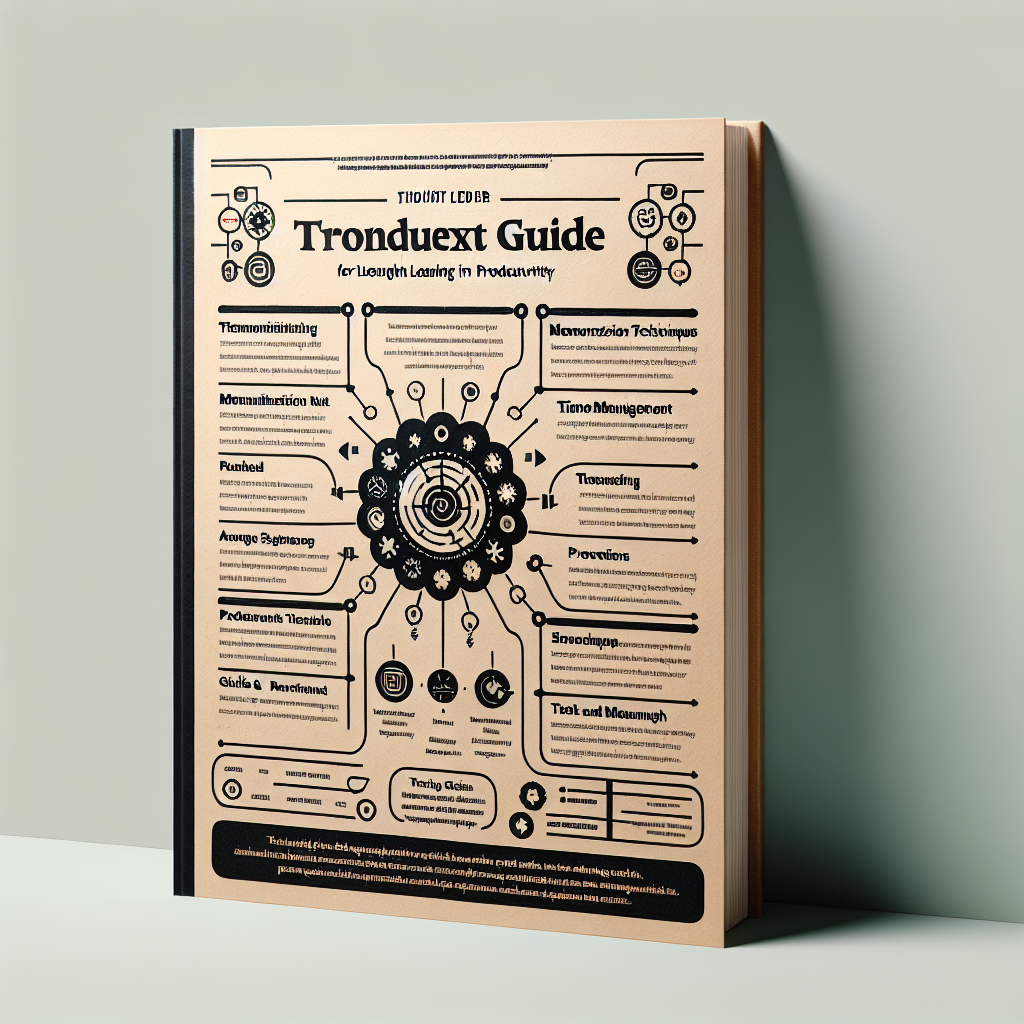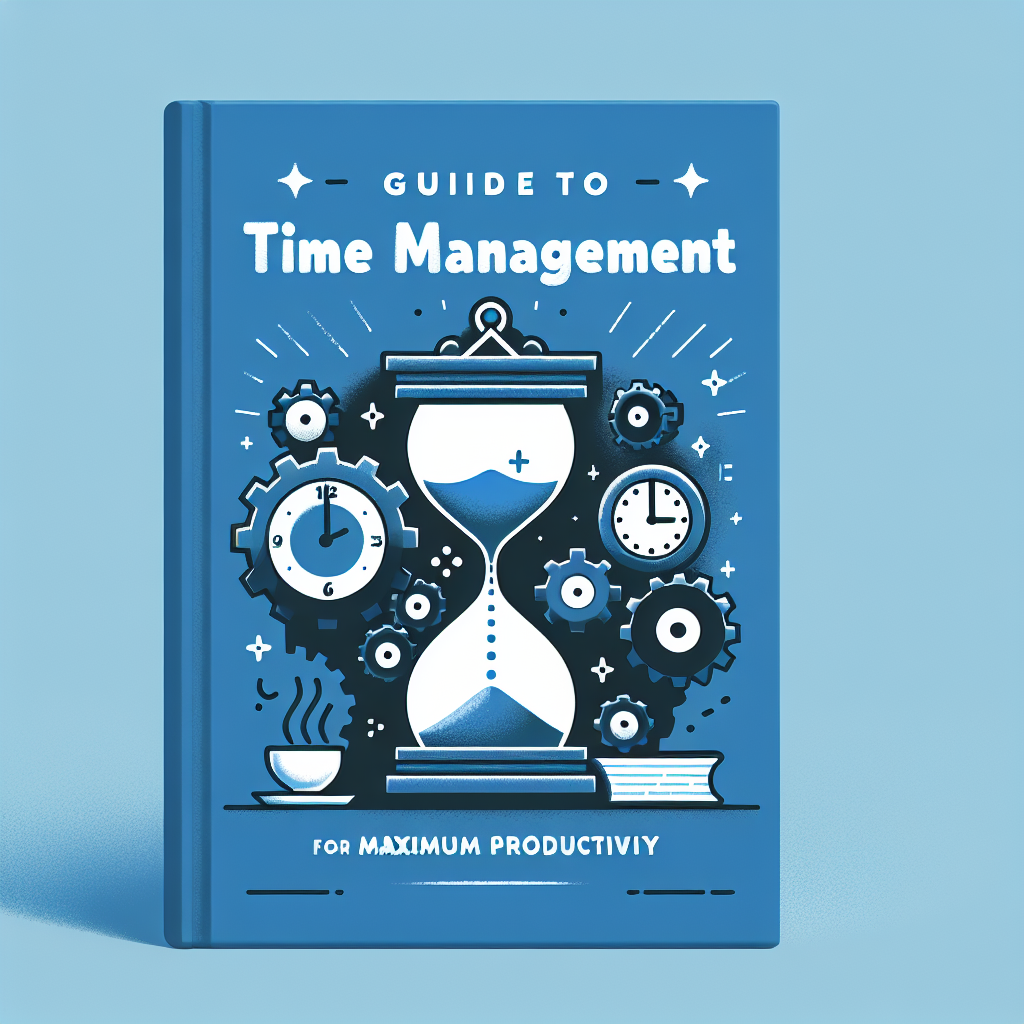How Tim Ferriss’ The 4-Hour Workweek Can Change Your Entrepreneurial Life
Maximizing Productivity: Key Takeaways from The 4-Hour Workweek
Tim Ferriss’ ”The 4-Hour Workweek” has become a seminal guide for entrepreneurs seeking to maximize productivity and achieve a more balanced lifestyle. The book offers a wealth of strategies designed to help individuals break free from the traditional 9-to-5 grind and create a life of freedom and flexibility. One of the key takeaways from Ferriss’ work is the importance of focusing on high-impact activities. By identifying and prioritizing tasks that yield the most significant results, entrepreneurs can make more efficient use of their time. This concept, often referred to as the Pareto Principle or the 80/20 rule, suggests that 80% of outcomes come from 20% of efforts. By honing in on these critical tasks, you can significantly boost your productivity and achieve your goals more quickly.
Another crucial aspect of Ferriss’ philosophy is the delegation of tasks. He emphasizes the value of outsourcing non-essential activities to free up time for more important pursuits. This can involve hiring virtual assistants, leveraging automation tools, or even collaborating with other professionals. By delegating routine tasks, you can focus on strategic planning, innovation, and other high-value activities that drive your business forward. Moreover, Ferriss encourages entrepreneurs to embrace the concept of mini-retirements. Instead of waiting until the traditional retirement age to enjoy life, he advocates for taking extended breaks throughout your career. These mini-retirements can provide opportunities for personal growth, exploration, and rejuvenation, ultimately leading to a more fulfilling and balanced life.
In addition to these strategies, Ferriss also highlights the importance of setting clear boundaries. By establishing specific work hours and sticking to them, you can create a healthier work-life balance. This approach not only helps prevent burnout but also ensures that you have time to invest in personal relationships, hobbies, and self-care. Furthermore, Ferriss underscores the significance of continuous learning and self-improvement. He encourages entrepreneurs to invest in their personal and professional development by reading, attending workshops, and seeking out new experiences. This commitment to growth can help you stay ahead of industry trends, develop new skills, and maintain a competitive edge in the marketplace.
Another key takeaway from ”The 4-Hour Workweek” is the power of effective goal setting. Ferriss advocates for setting specific, measurable, achievable, relevant, and time-bound (SMART) goals. By breaking down your objectives into smaller, manageable tasks, you can create a clear roadmap for success. This approach not only helps you stay focused and motivated but also enables you to track your progress and make adjustments as needed. Additionally, Ferriss emphasizes the importance of cultivating a strong support network. Surrounding yourself with like-minded individuals who share your values and aspirations can provide invaluable encouragement, advice, and inspiration. By building a community of supportive peers, you can navigate the challenges of entrepreneurship with greater confidence and resilience.
Finally, Ferriss encourages entrepreneurs to embrace a mindset of experimentation and adaptability. In today’s rapidly changing business landscape, the ability to pivot and adjust your strategies is crucial for long-term success. By remaining open to new ideas and approaches, you can continuously refine your processes and stay ahead of the competition. In conclusion, Tim Ferriss’ ”The 4-Hour Workweek” offers a comprehensive blueprint for maximizing productivity and achieving a more balanced entrepreneurial life. By focusing on high-impact activities, delegating tasks, embracing mini-retirements, setting clear boundaries, investing in continuous learning, setting effective goals, cultivating a support network, and maintaining a mindset of adaptability, you can transform your approach to work and create a life of greater freedom and fulfillment.
Outsourcing Effectively: Lessons from Tim Ferriss
Tim Ferriss’ ”The 4-Hour Workweek” has become a seminal guide for entrepreneurs seeking to optimize their work-life balance and maximize productivity. One of the most transformative concepts Ferriss introduces is the art of outsourcing effectively. By delegating tasks that are time-consuming or outside your expertise, you can focus on what truly matters: growing your business and enjoying your life. This approach not only streamlines operations but also empowers you to leverage global talent, often at a fraction of the cost.
To begin with, Ferriss emphasizes the importance of identifying tasks that can be outsourced. These are typically repetitive, administrative, or specialized tasks that do not require your direct involvement. For instance, managing emails, scheduling appointments, and handling customer service can be efficiently managed by virtual assistants. By offloading these responsibilities, you free up valuable time to concentrate on strategic planning and creative endeavors that drive your business forward.
Moreover, Ferriss advocates for the use of virtual assistants from countries with lower labor costs, such as the Philippines or India. This not only reduces expenses but also provides access to a pool of highly skilled professionals. Websites like Upwork, Fiverr, and Freelancer make it easy to find and hire virtual assistants who can meet your specific needs. Ferriss suggests starting with small tasks to test the waters and gradually increasing the workload as trust and competence are established.
Transitioning to the practical aspects of outsourcing, clear communication is paramount. Ferriss advises creating detailed instructions and setting clear expectations to ensure tasks are completed to your satisfaction. Tools like Trello, Asana, and Slack can facilitate project management and communication, making it easier to track progress and provide feedback. Regular check-ins and updates help maintain accountability and ensure that any issues are promptly addressed.
Another key lesson from Ferriss is the importance of focusing on results rather than micromanaging processes. By setting clear goals and outcomes, you empower your virtual assistants to take ownership of their tasks and find the most efficient ways to complete them. This not only fosters a sense of responsibility but also encourages innovation and problem-solving. Trusting your team to deliver results can lead to higher productivity and a more motivated workforce.
Furthermore, Ferriss highlights the significance of leveraging technology to automate routine tasks. Tools like Zapier, IFTTT, and various CRM systems can automate workflows, reducing the need for manual intervention. By integrating these tools into your business operations, you can further streamline processes and enhance efficiency. Automation, combined with effective outsourcing, creates a powerful synergy that can significantly boost your productivity.
In addition to these practical tips, Ferriss also touches on the psychological benefits of outsourcing. Delegating tasks can alleviate stress and prevent burnout, allowing you to maintain a healthier work-life balance. This, in turn, can lead to increased creativity, better decision-making, and a more sustainable approach to entrepreneurship. By focusing on what you do best and outsourcing the rest, you create a more fulfilling and enjoyable entrepreneurial journey.
In conclusion, Tim Ferriss’ ”The 4-Hour Workweek” offers invaluable insights into outsourcing effectively. By identifying tasks that can be delegated, leveraging global talent, communicating clearly, focusing on results, and utilizing technology, you can transform your entrepreneurial life. Outsourcing not only enhances productivity but also promotes a healthier work-life balance, enabling you to achieve your business goals while enjoying the freedom and flexibility that entrepreneurship promises.
Embracing the New Rich Lifestyle: A Guide for Entrepreneurs
Tim Ferriss’ ”The 4-Hour Workweek” has become a seminal guide for entrepreneurs seeking to break free from the traditional 9-to-5 grind and embrace a lifestyle of freedom and flexibility. At its core, the book introduces the concept of the ”New Rich,” a group of individuals who prioritize time and mobility over material wealth. By adopting Ferriss’ principles, entrepreneurs can transform their approach to work and life, achieving a balance that fosters both personal and professional growth.
One of the key tenets of Ferriss’ philosophy is the idea of lifestyle design. Rather than deferring dreams and aspirations until retirement, Ferriss advocates for integrating them into the present. This shift in mindset encourages entrepreneurs to focus on what truly matters to them, whether it’s traveling the world, spending more time with family, or pursuing a passion project. By identifying and prioritizing these goals, individuals can create a life that is both fulfilling and sustainable.
To achieve this, Ferriss introduces the concept of the ”DEAL” framework: Definition, Elimination, Automation, and Liberation. The first step, Definition, involves clearly articulating what you want out of life and setting specific, measurable goals. This clarity provides a roadmap for making decisions and taking actions that align with your desired lifestyle.
Next, Elimination focuses on removing unnecessary tasks and distractions that consume time and energy. Ferriss emphasizes the importance of the 80/20 principle, which states that 80% of results come from 20% of efforts. By identifying and concentrating on the most impactful activities, entrepreneurs can streamline their workload and increase efficiency. This often involves saying no to low-value tasks and delegating responsibilities to others.
Automation is the third component of the DEAL framework, and it involves leveraging technology and outsourcing to minimize manual work. Ferriss encourages entrepreneurs to use tools and services that can handle repetitive tasks, freeing up time for more strategic and creative endeavors. For instance, automating email responses, scheduling social media posts, or hiring virtual assistants can significantly reduce the daily grind and allow for greater focus on high-priority projects.
Finally, Liberation is about breaking free from the constraints of a traditional office environment. Ferriss advocates for remote work and flexible schedules, enabling entrepreneurs to work from anywhere in the world. This not only enhances work-life balance but also opens up opportunities for travel and exploration. By embracing a location-independent lifestyle, entrepreneurs can experience new cultures, gain fresh perspectives, and foster innovation.
Transitioning to the New Rich lifestyle also requires a shift in mindset regarding income and expenses. Ferriss challenges the conventional notion that wealth is solely about accumulating money. Instead, he posits that true wealth is measured by the ability to control one’s time and pursue meaningful experiences. This perspective encourages entrepreneurs to focus on creating multiple streams of passive income, which can provide financial stability without demanding constant attention.
Moreover, Ferriss highlights the importance of continuous learning and personal development. By investing in skills and knowledge, entrepreneurs can stay adaptable and resilient in an ever-changing business landscape. This commitment to growth not only enhances professional capabilities but also enriches personal fulfillment.
In conclusion, Tim Ferriss’ ”The 4-Hour Workweek” offers a transformative approach for entrepreneurs seeking to embrace the New Rich lifestyle. By redefining success, eliminating inefficiencies, automating tasks, and liberating themselves from traditional work constraints, individuals can create a life that is both prosperous and purposeful. Through this journey, entrepreneurs can achieve a harmonious balance between work and life, ultimately leading to greater happiness and fulfillment.
Automating Your Business: Strategies Inspired by The 4-Hour Workweek
Tim Ferriss’ ”The 4-Hour Workweek” has become a seminal guide for entrepreneurs seeking to optimize their work-life balance while maximizing productivity. One of the most transformative concepts Ferriss introduces is the idea of automating your business. By implementing automation strategies, entrepreneurs can free up valuable time, reduce stress, and focus on what truly matters. This approach not only enhances efficiency but also paves the way for sustainable growth.
To begin with, Ferriss emphasizes the importance of identifying repetitive tasks that consume a significant portion of your time. These tasks, often mundane and time-consuming, can be delegated or automated to streamline operations. For instance, customer service inquiries, appointment scheduling, and social media management are areas ripe for automation. By utilizing tools like chatbots, scheduling software, and social media automation platforms, entrepreneurs can ensure these tasks are handled efficiently without constant manual intervention.
Moreover, Ferriss advocates for the use of virtual assistants (VAs) to manage tasks that require a human touch but do not necessarily need your direct involvement. Hiring a VA can be a game-changer, allowing you to delegate administrative duties, research, and even some aspects of customer service. This not only frees up your time but also enables you to focus on strategic decision-making and creative endeavors that drive your business forward.
In addition to delegating tasks, Ferriss encourages entrepreneurs to adopt the Pareto Principle, also known as the 80/20 rule. This principle suggests that 80% of your results come from 20% of your efforts. By identifying and focusing on the most impactful activities, you can eliminate or automate the less critical tasks that do not significantly contribute to your business’s success. This targeted approach ensures that your time and energy are invested in high-value activities that yield the greatest returns.
Furthermore, Ferriss highlights the importance of creating systems and processes that can operate independently of your constant supervision. This involves documenting workflows, standard operating procedures (SOPs), and establishing clear guidelines for your team. By doing so, you create a self-sustaining business model that can function smoothly even in your absence. This level of autonomy not only reduces your workload but also empowers your team to take ownership and make informed decisions.
Another key aspect of automation inspired by ”The 4-Hour Workweek” is leveraging technology to streamline communication and collaboration. Tools like project management software, cloud storage, and communication platforms can significantly enhance team productivity and coordination. By centralizing information and facilitating seamless communication, these tools minimize misunderstandings and ensure everyone is on the same page.
Additionally, Ferriss underscores the value of continuous improvement and optimization. Automation is not a one-time effort but an ongoing process that requires regular evaluation and refinement. By consistently analyzing your workflows and seeking opportunities for improvement, you can stay ahead of the curve and adapt to changing business needs. This proactive approach ensures that your business remains agile and resilient in the face of challenges.
In conclusion, automating your business, as inspired by Tim Ferriss’ ”The 4-Hour Workweek,” can revolutionize your entrepreneurial life. By identifying repetitive tasks, leveraging virtual assistants, adopting the Pareto Principle, creating self-sustaining systems, utilizing technology, and committing to continuous improvement, you can achieve a more balanced and productive work-life dynamic. Embracing these strategies not only enhances efficiency but also empowers you to focus on what truly matters, ultimately driving your business toward long-term success.
Achieving Work-Life Balance: Insights from Tim Ferriss’ Philosophy
Tim Ferriss’ ”The 4-Hour Workweek” has become a seminal guide for entrepreneurs seeking to revolutionize their approach to work and life. At its core, Ferriss’ philosophy challenges the traditional notion of the 9-to-5 grind, advocating instead for a lifestyle that prioritizes efficiency, automation, and the pursuit of personal passions. By embracing these principles, entrepreneurs can achieve a more balanced and fulfilling life.
One of the key insights from Ferriss’ book is the concept of ”lifestyle design.” Rather than conforming to societal expectations of work, Ferriss encourages individuals to envision their ideal life and then reverse-engineer their career to support that vision. This approach requires a shift in mindset, from working for the sake of working to working with a purpose. By focusing on what truly matters, entrepreneurs can allocate their time and energy more effectively, leading to greater satisfaction and productivity.
Another fundamental aspect of Ferriss’ philosophy is the Pareto Principle, or the 80/20 rule. This principle suggests that 80% of results come from 20% of efforts. By identifying and concentrating on the most impactful tasks, entrepreneurs can maximize their output while minimizing wasted time. This selective focus not only enhances efficiency but also frees up time for personal pursuits and relaxation, contributing to a healthier work-life balance.
In addition to prioritizing tasks, Ferriss advocates for the automation of routine processes. By leveraging technology and outsourcing, entrepreneurs can delegate mundane tasks and focus on high-value activities. This approach not only streamlines operations but also reduces the mental burden of managing every aspect of a business. For instance, using virtual assistants for administrative tasks or employing software for customer relationship management can significantly lighten the workload, allowing entrepreneurs to concentrate on strategic growth and innovation.
Moreover, Ferriss emphasizes the importance of setting boundaries and establishing clear work-life separation. In a world where technology blurs the lines between professional and personal life, it is crucial to create distinct periods for work and leisure. By doing so, entrepreneurs can prevent burnout and maintain their well-being. Ferriss suggests techniques such as time-blocking, where specific hours are dedicated to focused work, and digital detoxes, where individuals disconnect from electronic devices to recharge.
Furthermore, Ferriss introduces the concept of ”mini-retirements,” which involves taking extended breaks throughout one’s career rather than waiting for traditional retirement. These breaks provide opportunities for travel, learning new skills, or simply enjoying life. By incorporating mini-retirements into their schedules, entrepreneurs can experience the benefits of relaxation and rejuvenation, ultimately enhancing their creativity and productivity when they return to work.
In addition to these practical strategies, Ferriss’ philosophy also underscores the importance of cultivating a growth mindset. Embracing challenges, learning from failures, and continuously seeking improvement are essential for long-term success. By adopting this mindset, entrepreneurs can navigate the uncertainties of business with resilience and adaptability, ultimately achieving a more balanced and fulfilling life.
In conclusion, Tim Ferriss’ ”The 4-Hour Workweek” offers valuable insights for entrepreneurs striving to achieve work-life balance. By embracing lifestyle design, prioritizing impactful tasks, automating routine processes, setting boundaries, incorporating mini-retirements, and cultivating a growth mindset, individuals can transform their approach to work and life. This holistic philosophy not only enhances efficiency and productivity but also fosters a sense of fulfillment and well-being. By applying these principles, entrepreneurs can create a life that aligns with their passions and values, ultimately leading to a more balanced and rewarding entrepreneurial journey.




















